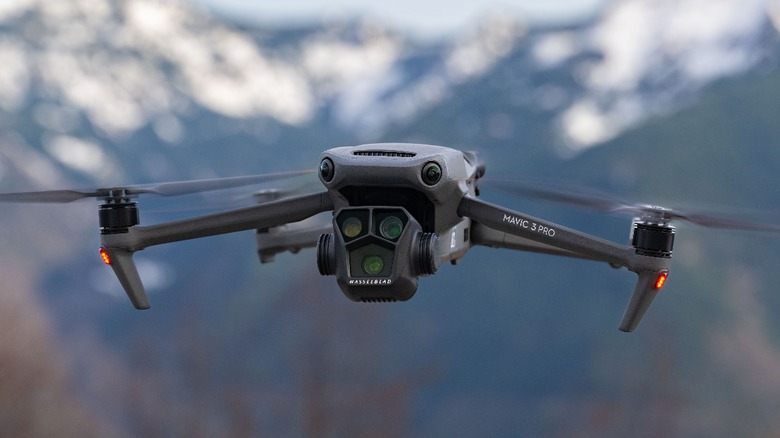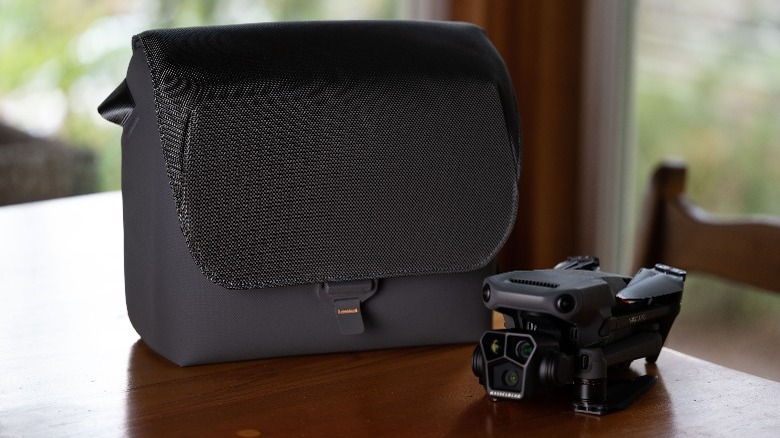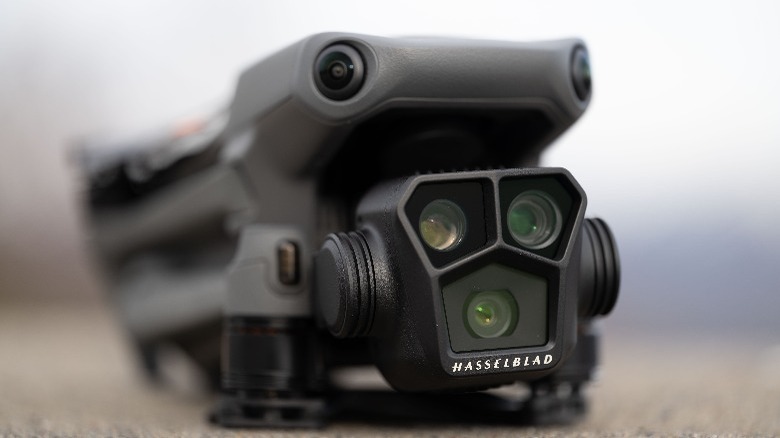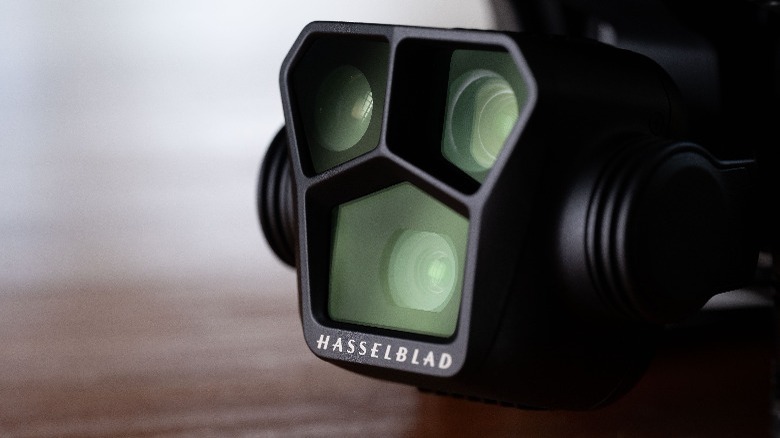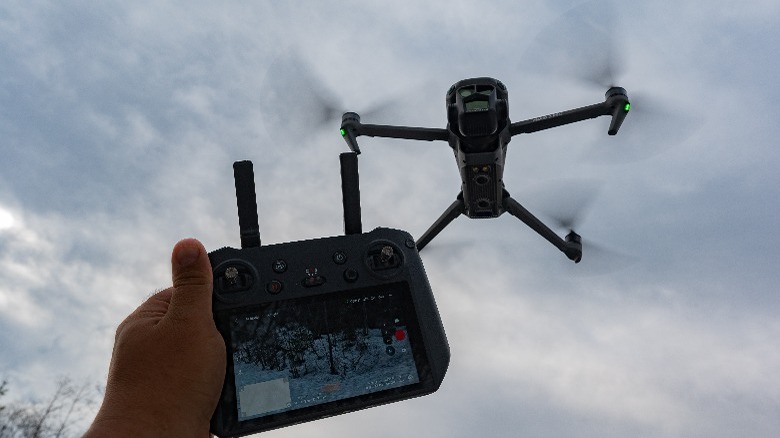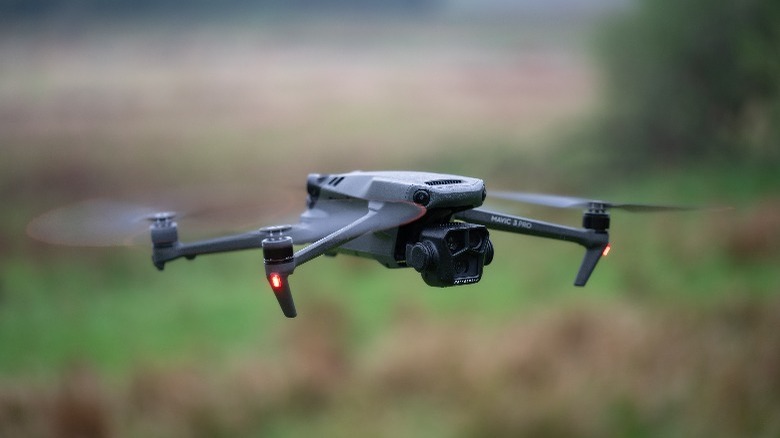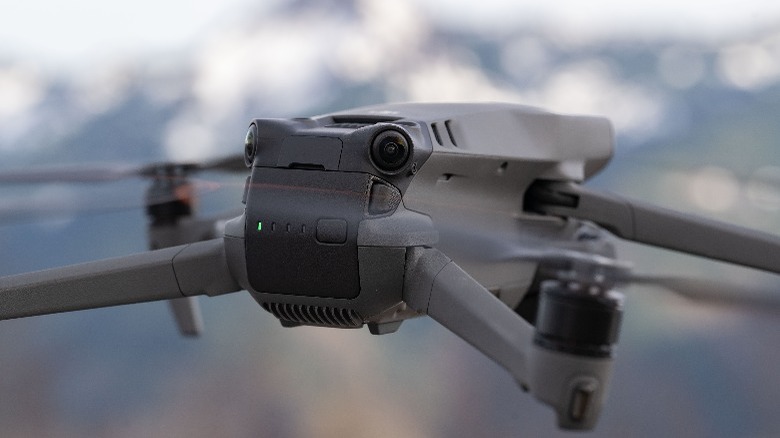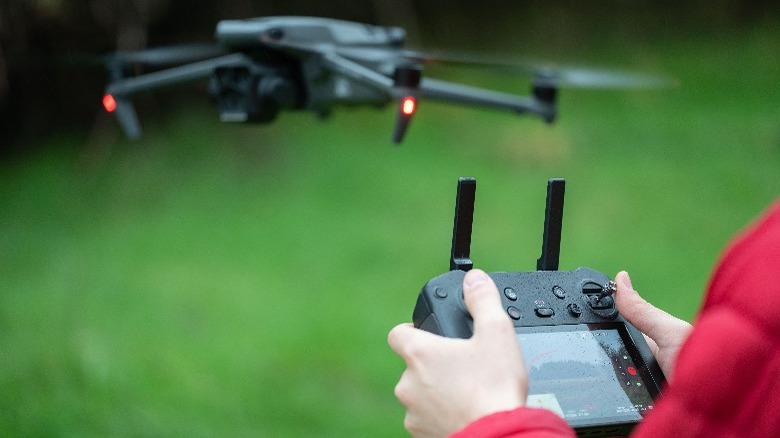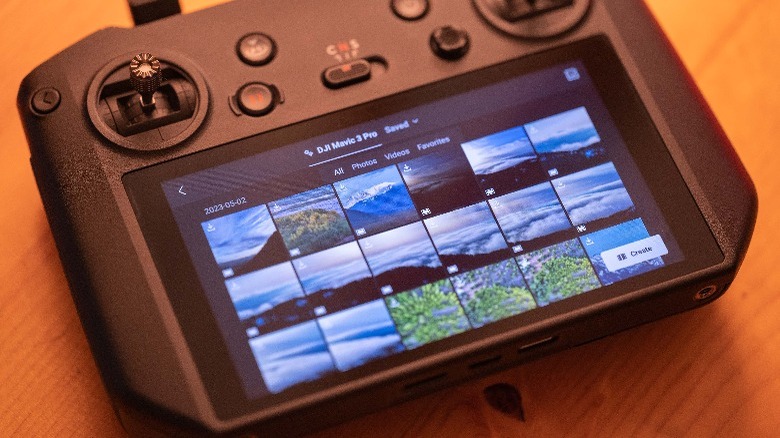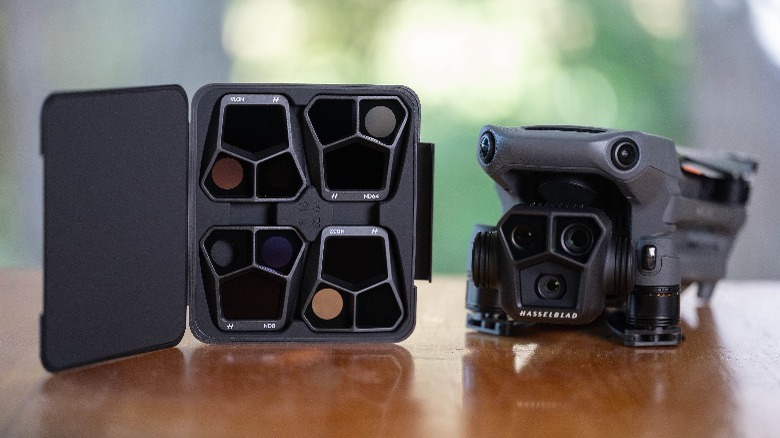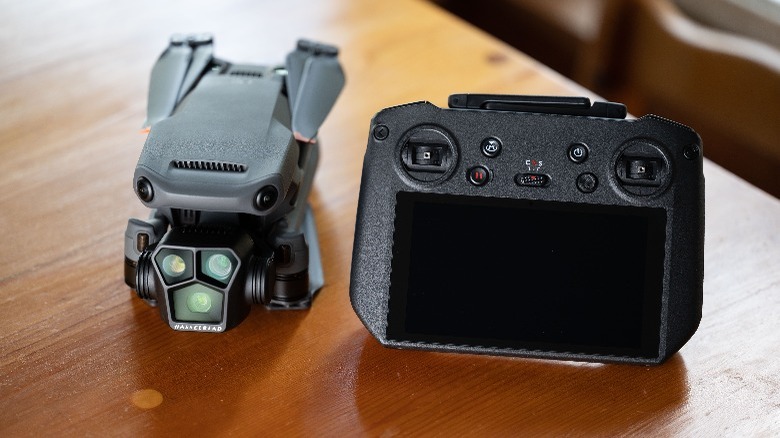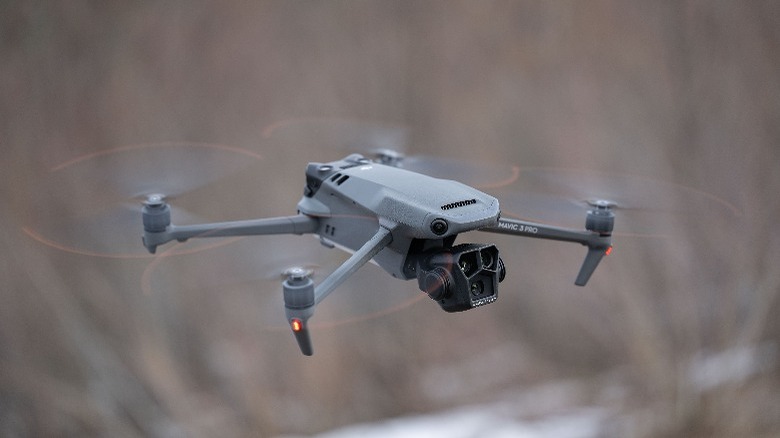DJI Mavic 3 Pro Review: The More Cameras The Merrier
- Telephoto lens adds cinematic versatility
- Extremely quick to acquire GPS signal
- Base model is only $150 more than the original Mavic 3
- Advanced, well-considered software
- Hasselblad wide angle camera
- Robust image transmission and RC connection
- Expensive
First launched in November of 2021, the original DJI Mavic 3 featured a camera that is still without rival in consumer-level drones. Now with the Mavic 3 Pro, DJI has pushed this line of drones still further ahead with the addition of a third lens, which at least on paper adds even greater versatility to an already formidable aerial camera system. With this third camera, you essentially have access to three high-quality prime lenses with dedicated cameras behind them. It's like owning a DSLR with multiple lenses, but never needing to go through the hassle of manually changing between them.
The Mavic 3 Pro is basically a replacement for the original Mavic 3, with that older model seemingly discontinued. It marks a major mid-generation refresh, which presents a tempting boost to an already powerful aerial imaging system to entice new drone pilots to the pinnacle of consumer drone technology. Beyond its new third eye, the Mavic 3 Pro possesses everything that made older Mavic 3 drones so desirable to drone pilots looking for the best of the best.
Familiar design, streamlined setup
The Mavic 3 Pro is fundamentally a Mavic 3 with an extra camera, so the main physical differences are weight and size. The Pro weighs 958 grams as opposed to the 895 grams of the original Mavic 3, but it's not enough of a difference that you'd be able to tell, even holding one drone in either hand. The Pro is also 231.1×98×95.4 mm when folded and 347.5 x 290.8 × 107.7 mm when unfolded, while the original Mavic 3 is 221 × 96.3 × 90.3 mm when folded and 347.5 × 283 × 107.7 mm when unfolded. While on paper the Mavic 3 Pro is larger, it's as similarly negligible as the difference in weight.
The setup process is very quick and painless, with none of the teething problems occasionally experienced with new DJI drones at launch. Getting the Mavic 3 Pro up and running was a smooth and straightforward experience. Just charge up the battery and follow the prompts in the app and you'll soon be ready to take off.
New camera opens up fresh perspectives
While the Mavic 3 Pro features the same unrivaled 24mm 20MP wide angle Hasselblad camera with an M4/3 size sensor, as well as the long 166mm equivalent telephoto camera with a ½ inch sensor as found on the original Mavic 3, the Mavic 3 Pro incorporates a third camera with a focal length equivalent to 70mm. This medium-range telephoto camera is equipped with a 12MP, 1/1.13 size sensor. This provides a much-needed middle ground for shots where you need to punch in a little bit, but where extreme zoom isn't needed. As most drone pilots are used to using exclusively wide-angle lenses, it's difficult to realize what this means for the Mavic 3, but once you start shooting with it, the idea of a drone without it is hard to envision.
In practice, having a moderate telephoto camera is immensely useful for diversifying footage, as it allows you to punch in a bit and isolate your subject. With it, you can capture more motion in your footage and achieve a noticeable parallax effect.
The only technical glitch experienced by the drone during testing was with the new medium telephoto camera, where very occasionally when pulling off a complex maneuver and simultaneously moving the angle of the camera, it would sometimes experience a judder where the camera suddenly jerked to one side. This only occurred a few times, and only with the medium telephoto lens.
Telephoto lenses offer unique capabilities
Between its three cameras, the Mavic 3 Pro is without a doubt the most capable all-in-one system for aerial photography and videography. While more powerful systems, such as the DJI Inspire 3 exist for eight times the price and utilize interchangeable lenses, it can't swap between three different lenses with the touch of a button like the Mavic 3 Pro can. For example, while filming beside a river a flock of mergansers flew past, and I was able to swap to the 70mm camera instantly and rotate the drone to film them as they went past. Recording in 60fps, the result was a beautiful shot captured at the moment that would have been impossible to record so well with any other drone.
The 166mm super telephoto is what made the original Mavic 3 the only drone capable of filming wildlife without disturbing sensitive creatures. It was possible to use this to capture footage of beavers working in their ponds without them being aware of the presence of the drone. Of course, it's always necessary to maintain a safe distance, and not actually approach animals with a drone. The USDA recommends you keep a minimum of 100 meters away from wildlife. The super telephoto camera is also great for filming other distant subjects without needing to fly the drone closer to them. This camera on the Mavic 3 Pro seems to offer slightly better performance than the super telephoto camera on the original Mavic 3.
Wide angle camera with a massive sensor
The wide-angle Hasselblad camera is identical to that on the original Mavic 3, but that's no bad thing. This sensor and lens deliver truly stunning quality, even in extreme low light conditions. It's so good in fact that the images it delivers rival those captured by pro-grade DSLR and mirrorless cameras. This is largely thanks to it having an M4/3 size sensor, which is much larger than sensors found on most other drones. Additionally, it features a variable aperture that ranges from F/2.8 to F/11. This is extremely helpful, both for adjusting depth of field and for controlling how much light reaches the sensor.
The images and video captured through this camera are genuinely breathtaking, and it not only shoots highly detailed color-accurate 20MP photos, but it also is capable of shooting 5.1K video at up to 50fps. The wide-angle camera can also shoot 4K at up to 120fps in a dedicated slow-motion mode and can shoot in HNCS, HLG, D-log, D-log M, and night video color modes. It's important to note that the medium and super telephoto cameras do not support all the features, color modes, and resolutions/framerates of the wide-angle camera, though fortunately, all cameras on the drone are capable of shooting 4K video at 60fps.
If you're not interested in telephoto cameras, and all you want is the wide-angle Hasselblad camera, then you should definitely consider the Mavic 3 Classic, which is only $1,599.
Shockingly fast satellite acquisition.
A long-running issue with the original Mavic 3, and an irritating aspect of many drones, is acquiring enough of a satellite connection in order to unlock the full functionality of the drone. At launch, the original Mavic 3 was really problematic in this regard, though it improved dramatically with subsequent software updates. Almost every drone takes a bit of time sitting there gradually acquiring satellites.
The Mavic 3 Pro suffers from no such affliction. Satellite acquisition is practically instantaneous in a reasonably open location. It only takes a couple of seconds under ideal conditions, and even in relatively challenging conditions for GPS, the Mavic 3 Pro didn't hesitate for long before it grabbed a solid connection. This is important because when you need to capture a fleeting moment, such as a rainbow or the sunset, every second matters. With the Mavic 3 Pro, the time to take off isn't too much more than that of a DSLR or mirrorless camera.
An important thing to note is that in testing, the original Mavic 3 with years of major updates wasn't far behind the Mavic 3 Pro in terms of GPS capability, but the Mavic 3 Pro nonetheless seemed faster and more consistent in this regard.
Quiet and fast
A big advantage of the Mavic 3 series is how quiet these drones are compared to other options on the market. The Mavic 3 Pro performs just as well as its siblings, which means there's much less of an issue with the drone bothering other people who may be nearby and wouldn't appreciate a loud buzzing overhead. It's always best for drone pilots to take great care not to disturb other people and animals, so the quiet flight of the Mavic 3 Pro is one of its best qualities.
Despite how little noise it produces, the Mavic 3 Pro is no slouch when it comes to speed. It can ascend at up to 8 m/s, descend at up to 5 m/s, and travel horizontally at up to 21 m/s, which works out to 47 mph. Maximum speeds are available in sport mode, where obstacle sensing is disabled. Equally as useful is the slow-speed cinematic mode which is ideal for navigating in confined spaces or following a slow-moving subject.
Long flight times thanks to high capacity batteries
Battery life is also good, with the drone being able to fly as long as 43 minutes, though that's reduced to 37 minutes if you're just hovering. That's a lot of time to have the drone in the air on a single battery, so having a couple spare batteries in your bag should cover all but the most intense days of aerial photography. During a particularly long afternoon of testing which drained all three batteries included with the fly more kit, the drone spent roughly an hour and a half in the air, which left each battery with around 15% charge.
Similarly, the DJI RC Pro controller has an impressively long battery life, with an hour and half worth of heavy use only depleting less than 50% of the battery. The DJI RC and RC-N1 controllers also offer great battery life if you choose to use one of them instead. Comparing the Mavic 3 Pro to older drones such as the Mavic 3 series, it's great that battery life is no longer really a concern.
Strong, long range connection, and great controller options
Flying the Mavic 3 Pro with the DJI RC Pro controller is a dream in terms of signal strength and video transmission. There was never any issue with loss of signal or lag with the livestream from the drone. The Mavic 3 Pro utilizes DJI's Occusync 3+, which has a range of up to 7 km. You probably won't be flying such extreme distances with it, but that means that for short range flights you'll enjoy a really robust signal.
The less expensive DJI RC remote isn't as tough and high performing as the RC Pro remote, but it's a great option if you're looking to save some money as opposed to paying for the very expensive RC Pro. Alternatively, if flying with a tablet or smartphone is more your style, then the RC-N1 remote is the way to go, though note that there's no option to bundle the RC-N1 with the Mavic 3 Pro, so you'll need to buy it separately if that's what you want to use.
Robust software and advanced features
With years of Mavic 3 development behind it, the Mavic 3 Pro boasts a software user experience that's remarkably polished. Changing settings, choosing options, and operating the drone via touchscreen controls is fluid and intuitive. Features are equally well developed, with everything from advanced timelapse controls to subject tracing, APAS obstacle avoidance, and a variety of automated shots which yield great results even in the hands of novice pilots. There's even a waypoint system for automated flights, which is essential for shots where it's necessary to repeat the same flight pattern multiple times, such as a transition between winter and spring where snowdrifts give way to flowers and fresh green leaves.
The one thing missing here is that DJI hasn't released an SDK for Mavic 3 drones, aside from the high end enterprise models. This means that third party apps won't work with the Mavic 3 Pro unless DJI releases an SDK for the system. While many pilots will be perfectly happy and content with DJI's excellent app and its myriad of options, there are professional cinematographers for whom third party apps are an absolute necessity. Those professionals can of course get an enterprise level Mavic 3 instead, but they don't include the excellent medium telephoto camera available on the Mavic 3 Pro.
High quality ND filters
Three separate cameras require very specifically designed filters, and fortunately, DJI sells a high-quality set of ND filters at launch (they're included if you purchase one of the available Fly More or Premium combos). ND filters allow you to compensate for bright conditions in order to achieve desired exposure settings. Poor-quality ND filters can add unwanted tint to your image and degrade sharpness.
Fortunately, DJI's filter set for the Mavic 3 Pro is extremely high quality, offering ND8, ND16, ND32, and ND64 options. Happily, they don't alter the color or degrade sharpness to a noticeable degree, and provide an even, neutral reduction of light to the sensor. The filters lock securely over the cameras, and with practice are easy and quick to swap out. They come in a protective case that fits easily into the standard carrying case for the Mavic 3 Pro. While somewhat pricey at $179, this is in line with what you should expect high-quality ND filters to cost.
High price, but good value for the money
Starting at $2,199, the Mavic 3 Pro is just $150 more than the original Mavic 3, and for the difference in cost, the Pro is a big upgrade. Having that 70mm camera adds a ton of flexibility, and the value of the improved GPS system should not be underestimated. The Mavic 3 Pro is also available in two separate Fly More Combo packages, the first of which adds in two additional batteries, a battery charging hub, an ND filters set, among other accessories, for $2,999. For $3,889 you can swap out the DJI RC for the DJI RC Pro, and at $4,799 you get the DJI Mavic 3 Pro Cine Premium Combo which comes with an internal 1TB SSD in the drone and support for Apple ProRes.
Compared to buying everything separately, the Fly More combo offers roughly a $200 discount. With that said, if you don't need the ND filters ($179) and carrying bag ($319) you could buy the extra batteries, charging hub, and power adapter separately in order to save around $300. The more expensive bundle with the DJI RC Pro is actually a much better value since you get the $1,199 RC Pro with the Mavic 3 Pro for only an additional $890 on top of the basic Fly More Combo. The Cine version of the Mavic 3 Pro is a good option only if you're a professional who needs those capabilities, despite the high price.
Conclusion
The Mavic 3 Pro is an incredible device that further expands the capabilities of what was already the best drone in the skies. If you're still flying an entry-level drone, or an older model such as the Mavic 2 series, there's never been a better time to upgrade. It's not quite so attractive to owners of the original Mavic 3 and Mavic 3 Classic, as those drones are still very recent and possess most of the features found in the Mavic 3 Pro.
If you're looking to buy the best drone at a price point that a hobbyist might still reasonably afford, and which is capable of professional work, the Mavic 3 Pro is that drone. Nothing else provides the same level of cinematic versatility available literally on the fly. The compact nature of this system compared to high-end drones such as the DJI Inspire 3 gives the Mavic 3 Pro an advantage in some situations, even compared to the most expensive, cutting-edge unmanned aerial vehicles available.
